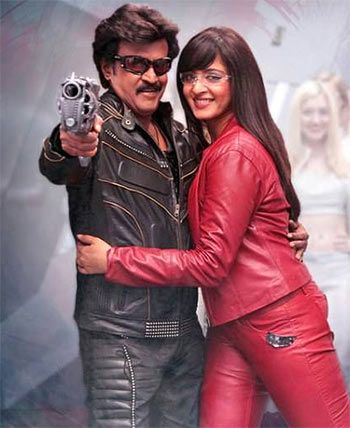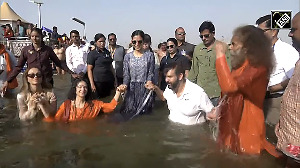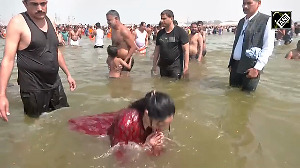 The Superstar turns 64 today, and his fans get a double birthday treat with Lingaa, says Saisuresh Sivaswamy.
The Superstar turns 64 today, and his fans get a double birthday treat with Lingaa, says Saisuresh Sivaswamy.
At almost three hours Lingaa is perhaps a tad too long, but the producer and director’s compulsions are understandable.
THE Superstar, as Rajinikanth is known to his legion of followers worldwide, returns to the silver screen in flesh and blood after a three-year hiatus (Shankar’s Endhiran/Robot in 2011 was his last); in the meantime there was only that blink-and-you-miss-it animation Kochadaiyaan.
As if to make up for lost time, there are even two Rajinikanths in Lingaa, grandfather and grandson who are both called Lingeshwar/Lingaa, and you are thankful there was no father-mother in between to stretch the plot further.
Yeah sure, the film does test your patience at times, but Rajini papers over those moments with his trademark charm, witty dialogues, and not a bit of help from his gang of thieves.
Yes, you read that right, contemporary Rajinikanth is a petty thief living in near penury, who disowns his heritage, in particular his grandfather, a king in British times, for not leaving any wealth behind for the family. The erstwhile royal’s present-day subjects, meanwhile, need him back badly to deliver them from some evil that is about to befall the dam built by the king against all odds.
That, in short, is the story. Now imagine it stretched to three hours.
The film’s basic premise is clearly laid out right at the beginning with the murder of an unknown man on the dam and who flings a rudraksha into an old temple before he dies.
The villagers realise that something is amiss and the villager elder convinces them that the only way to save themselves is to get the unknown heir of the king back.
Enter the present-day Rajni to trademark whistles and frenzy in the auditorium. It is a blast to watch the petty thief and his friends, including the irreplaceable Santhanam, go about their trade. The first 20 minutes or so pass by breezily, before they are tricked by Anushka Shetty into returning to the village.
With that you know a flashback is just round the corner. It is, and when the king with his opulence is introduced as the original Rajnikanth, you know it is a matter of time before he is tricked/volunteers into giving away his wealth to the people.
Since that is a recurring theme in the Superstar’s films, of the raja turning into a fakir, it should come as no surprise. Another imperative in a Rajni filim are the few giveaway dialogues scattered throughout that allude to his popularity among the masses, his good heart, service before self philosophy etc.
The flashback into British times is the culprit that stretches the film interminably into boredom territory, and it could easily have been truncated by 30 minutes, which would have made the film taut and a lot more enjoyable.
Unusually for a Rajini film, there aren’t that many fight sequences; the grandfather has one before the interval, as does the grandson in the climax. The first one is spectacularly choreographed, including a duel on a running train. The final clash is shorter, and aboard a hot air balloon, both fights elevated to another level thanks to some amazing CG work.
Naturally, all is well that ends well, and in the here and now, though the grandson does get served his just desserts at the end. Wittily, of course.
The length is not the only jarring point about the film.
There is the voluptuous Sonakshi Sinha who, apart from being a glorified prop, is the antithesis of a people living in drought-hit land where people are shown committing suicide to escape their misery. Think about it, hardly anyone in that village looks famine-hit, though the aridity of the land is the reason for the dam to come up.
Of the two heroines, the bolder Anushka Shetty shares a better chemistry with the Superstar. Perhaps because she is from a conservative era, Sonakshi, although shown to be the epitome of Subramaniya Bharathi’s Modern Woman, doesn’t have much of a crackle with Rajinikanth, not even in the mandatory dream sequence in Mona Gasolina.
And I know it is sacrilege to criticise A R Rahman’s music, but of the five songs in the film, only one, Indianey Vaa, had the anthem potential, the others being just about fine. You are welcome to disagree, of course.
But even where the songs didn’t jump out and grab you by the throat, the set designs simply stood out. Talking about which, art director Sabu Cyril’s work throughout the film is top-notch, and after Rajinikanth is the only other thing to linger on in your mind.
But, Rajnikanth.
What can you say about his onscreen charisma, his star value, that hasn’t been said before! His regal gait, his mannerisms, his style, they are simply unmatched, leaving much younger stars behind and gaping. And to believe that he turned 64 today!
An indicator of his longevity and evergreen status: actor Vijay Kumar, who plays a key role in the flashback, began his film career along with Rajinikanth all those years ago; Vijay Kumar used to be the hero then, and Rajni the villain. Slowly Rajni morphed into an actor, a hero, a star and finally the Superstar, leaving everyone far behind.
Director K S Ravikumar’s last outing was the atrocious Hindi film starring Sanjay Dutt, Policegiri, and going by it he should be given a wide berth. But he does have some good films to his credit in Tamil, including Kamal Hassan’s Dasavatharam. He also directed Rajni in two films, both block-busters: Padaiyappa and Muthu.
Does Lingaa fall in the same category? If you are a Rajini buff, yes, it definitely does.
Rediff Rating: 
(the third one is for THE Superstar).












 © 2025
© 2025